I hope you enjoy this blog post. If you want Hello Bar to grow your leads, click here.
Author:
Michael Wicker
Published
August 5, 2024
I hope you enjoy this blog post. If you want Hello Bar to grow your leads, click here.
Author:
Michael Wicker
Published
August 5, 2024

Content marketing is incredibly effective! In fact, 70% of organizations integrate it into their marketing strategies to boost site traffic and enhance search results effectively.
Well, you’ll be pleased to know that it’s much more affordable to launch and maintain than other digital marketing strategies. In fact, it costs 62% less!
In addition, content marketing revenue is expected to hit $107.5 billion by 2026.
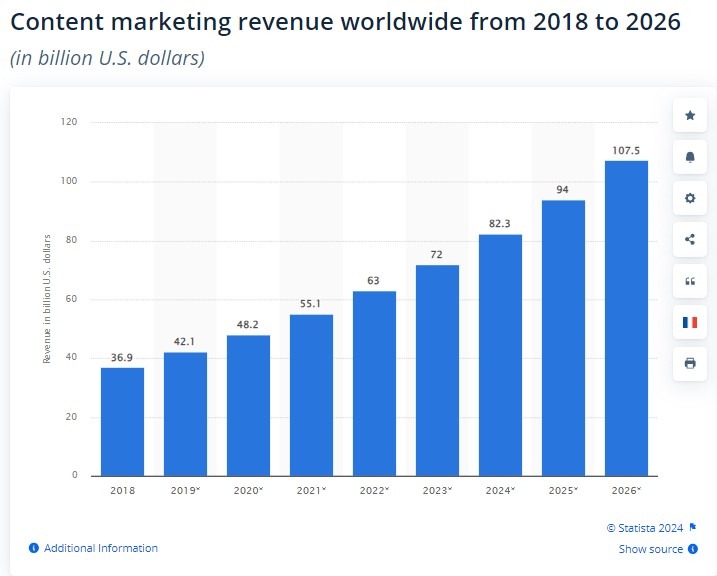
Image via Statista
So, what comes next once you’ve created valuable blog posts, video content, and social media posts?
Enter content promotion; the next step of increasing your web traffic.
Without a solid strategy to promote your content, even the best content may not reach its full potential. To ensure yours does, here are 13 content promotion tactics to boost website traffic.

Content promotion is the process of exposing your content to as many people as possible. The content could be a blog post, a sales page, an opt-in page, videos, gated content, podcasts, or other types of content.
Whatever the case, your job is to broadcast that content far and wide. Your goal is to get as many eyeballs on the content as possible.
There are two degrees of content promotion.
First-degree content promotion involves actively sharing content with your existing audience. You link to the content in emails, social media posts, SMSs, and more.
Second-degree content promotion occurs when others pick up the baton. They share your content with their audiences because they appreciate its value.
The best content promotion methods vary depending on your audience. Business owners and marketers have to experiment with different offers and CTAs.
That’s why A/B testing has become so imperative in marketing. If you don’t test different strategies, you’ll never know you could do better.
Some of the best methods of promotion include the following:

Let’s discuss 13 simple but effective ways to formulate an effective content promotion strategy.
As mentioned above, email marketing is extremely useful for content promotion. Whether you send out emails once a week or once a month, ensure you promote or link to your most valuable or popular blog posts in the email.
Content promotion only helps with lead generation and sales when you have an audience. Start collecting email addresses from your website visitors using a Hello Bar.
Select the “Grow Your Mailing List” goal in your Hello Bar account. In the first field, make a convincing offer; in the second, add a compelling CTA to subscribe.

The easiest way to deliver content is through an email service provider or ESP. The service keeps tabs on your subscriber list and allows you to send personalized, pre-scheduled emails to your audience.
You can also segment your audience. For instance, you might highlight one piece of content for people at the top of the sales funnel but mention a completely different article for people at the bottom of the funnel.
Emails get rerouted, accidentally deleted, and diverted into the wrong folders all the time. To keep tabs on your subscribers, send a follow-up email with the subject line, “In case you missed it…”
Resend the link to your favorite content for those who might not have seen it the first time.
You can also send individual emails to people who have large audiences. Invite them to share your content with their social media followers, blog readers, or other visitors.
This might get you a backlink to your content, which is the gift that keeps giving. Not only will it help your SEO, but it will also attract many people.
Consider mentioning movers and shakers in your industry in the content. You could quote them from an interview, promote their services, or name them as mentors.
People love to see their names “in print.” They might link to you or promote your content in gratitude.
Another way to promote your content is through search engines like Google. Search engine optimization (SEO) enables you to make your content more discoverable.
SEO takes time and effort, but it’s worth extra attention. If your content ranks for desirable keywords, you don’t have to do as much work in the future to make your website more accessible to your target audience.
Every piece of content you produce should have a focus, primary keyword, or key phrase. For instance, if you sell kitchen gadgets, you might want to rank for a keyword like “best food processor.” In SEO, keywords can have multiple words.
Related or semantic keywords help Google and other search engines understand your content. If you’re trying to rank for “best food processor,” you might want to use words like “cuisinart,” “food processor capacity,” and “chopping” in the content.
Interlinking your content makes it more search engine-friendly. Ideally, you want to link your newer posts to the posts that have proved most popular over the years so you pass the “SEO juice” from one piece of content to another.
Also, link your content to your oldest content. Interlinking improves your SEO and helps keep visitors on your website longer.
Email outreach can improve your big and small business SEO and enable content promotion. Use a tool like Ahrefs to identify the pages focused on a specific keyword that received the most backlinks and social shares.
Use the information to email the owners of websites that have linked to those particular content. Explain that you have written a longer, more in-depth piece and kindly request if they would consider linking to it if they find it valuable.
Social media can become a pivotal part of your content promotion strategy. It’s a great way to promote your content and increase your following.
X is a fast-moving social channel. Tweeting more frequently can help increase your following and boost your content promotion.
Consider using a tool like Buffer to schedule your tweets in advance. That way, you’re not constantly visiting Twitter to add links and other content to your account.
Tweet about your content.
Tweeting about your content can increase its readership. Use compelling headlines and hashtags to make your tweets discoverable.
Adding one or two hashtags per tweet can prove effective. However, you don’t want to overdo it and make your tweets look like spam. Consider testing different tweeting times to discover when your audience is most active on the platform.
Mention people who will like the article to increase content promotion
You can also @mention people on X when you link to specific types of content. If you know those people will appreciate the content, you increase their chances of sharing it with their audiences. Just make sure any mentions are relevant.
Tweeting a good quote from your new content is a great content promotion tool
X has increased its allowable character count, so use it to your advantage. Include a relevant quote from your content to increase click-through rates and tease the valuable information you’ve provided.
Make sharing easy with click-to-tweet buttons
A click-to-tweet button highlights a sentence or two from your content and encourages readers to tweet it. Punchy, valuable, or insightful passages from your content can go viral with the right content promotion tactics, so don’t hesitate to deploy these on your website with a plugin.
Pin tweets to the top of your X feed to increase content promotion
X allows you to pin certain tweets to the top of your feed. If you’ve shared a particularly valuable or popular piece of content, pin it to the top of your feed so more people see it. As mentioned above, X moves extremely quickly. Pinning tweets makes them more discoverable.
Just like X, Facebook can become extremely valuable for content promotion. People often share content they find valuable, even if they don’t actively follow your account.
Additionally, Facebook gives you more space than X. You can include longer content excerpts to intrigue your audience and convince them to click through.
Share your content with your Facebook page fans to increase content promotion
Remember to share your content on Facebook after it goes live. Make this part of your daily content promotion strategy.
Include the featured image on your post and a call to action, such as “Click to continue reading.” Depending on what works best for your audience, you can post an excerpt from the content or a summary.
Share your content on Facebook niche groups.
Consider joining Facebook groups and posting your content when it’s relevant. You don’t want to spam Facebook groups—that can get you kicked out—but if you’re a valuable part of the community, you can gain significant website traffic from these links.
Comment on related posts and link your new article to get more content promotion
Remember that social media is all about interaction. If you don’t visit pages other than your own, you’ll miss out on significant content promotion opportunities.
Visit other people’s pages in your industry, comment with valuable contributions, and link to your content when appropriate. Those people might reciprocate by sharing your link on a separate post.
When it comes to B2B lead generation, you won’t find a better platform than LinkedIn. This social channel can also prove valuable in B2C content promotion.
Think of LinkedIn as a massive professional conversation. It’s a way for people to connect based on their interests, professions, and job choices.
Direct message influencers on LinkedIn to increase your content promotion
The direct message feature on LinkedIn can help you connect with people who might be interested in the content as well as share the content. Sending DMs when appropriate can help spread your content more effectively.
You don’t want to spam people; that will have the opposite effect. Any DMs you send should have a specific, valuable purpose.
Share content on LinkedIn groups
Like Facebook, LinkedIn allows users to form groups based on common interests, professions, and goals. Join groups related to your industry and share content there.
You can publish excerpts of your content through the LinkedIn publishing system. This is a great way to increase its visibility and boost click-throughs to your website.
Millions of people use Reddit, but you have to realize that Redditors oppose overt marketing. You need to establish yourself as a valuable member of the community before you start content promotion efforts.
Find good subreddits to promote your content on Reddit
Start by following specific subreddits based on your industry and niche. Post valuable responses to user questions, then link to your content only when it’s helpful in a given situation.
Visual content can perform extremely well on Pinterest. Some highly Pinterest-worthy industries include fashion, fitness, food, home goods, architecture, interior design, and travel.
However, Pinterest is a platform that welcomes all types of content as long you can express it visually.
As mentioned above, Buffer (or Buffer alternatives) can prove extremely valuable for content promotion. Use it to schedule your social media posts days or even weeks in advance.
If you post consistently, you’ll gain more attention.
A piece of content doesn’t have to remain exclusively in its original form. You can repurpose it in a different medium to appeal to people who learn in various ways.
A blog post can become a marketing video, a video can become an infographic, and an infographic can become a podcast. Consider using new mediums to maximize your content promotion efforts and ensure visibility and reach through strategies like podcast SEO.
A video might appeal to people who learn best through visual and audio content. You could reiterate the main points of your latest blog post in a video, for instance.
You can post the video anywhere you want. We recommend starting with YouTube so you can use the share link to embed it elsewhere.
Infographics are highly shareable, which is why they’ve become so popular. Create your own infographic using a tool like Canva, or hire a professional to do it. Use an embed code to encourage others to share it in their content.
Consider repurposing your content in a slideshow. SlideShare is very popular because it’s searchable on the web and has an incredible user base.
An e-book makes a great lead magnet. Use it to collect email addresses from your audience and begin marketing to them directly.
Consider creating a Hello Bar that advertises your e-book. Let people know they can download it for free if they signup for your email newsletter.
You can also use other incentives along with the free download. Do you send out coupons or promotional codes via email? Tell your potential subscribers so they know they can save money on your products or services.
Podcasts work great for consumers who prefer to listen to content than read it. They can consume your podcast while driving to work, exercising, or getting ready for bed.
Repurpose a blog post or other piece of content into a podcast episode. Add new details or information to spruce it up and to ensure your listeners get maximum value.
Content syndication involves publishing your best-performing content on other sites. You can do this through self-publishing, such as on LinkedIn or Medium, or as guest posts.
Use the rel=”canonical” tag on the original post, so Google knows to index it first. Then, you can publish your content on other sites without fear of penalties for duplicate content.
The rel=”canonical” tag is an HTML tag that tells Google which version of duplicate content it should index. Ideally, you want content you have the right to and own to show up in Google search results.
The canonical tag goes in your post’s HTML. You can use a plugin like Yoast to include it automatically.
You can also create original content for other sites. Many industry blogs accept guest posts as long as they’re well-written and informative.
Use a Hello Bar to welcome people who visit your website via a guest post. You can use the referral source rule to target a Hello Bar to people who visit from a specific URL. It’s a unique personalization feature that can make people feel more welcome on your site.
Sometimes, you have to spend to boost your web presence. Paid promoted content can perform very well if you use the right platform and strategy.
Facebook Ads are easy to create. You can also use the same ads for Instagram if you want to utilize both platforms.
Choose an amount you want to spend, then whittle down your target audience based on demographics and other factors. You want people who see your ads to belong to your pool of target customers.
X ads cost significantly less than Facebook ads. This is because the ads become part of users’ regular feeds, so they seem more like friendly suggestions than ads.
Alternatively, advertise your content in search engines, such as Google and Bing. You have multiple options for SEM ads, so investigate them all. In addition to advertising on the search engines themselves, you can also join their ad networks so your ads appear on partner sites.
Ad retargeting is an extremely beneficial strategy to lure people back to your website. You’ll target your ads to people who have already visited your website and are, therefore, brand-aware.
Facebook and other social platforms support retargeting. You’ll install a pixel or another code on your website so the ad network can recognize visitors who have already been exposed to your site.
Recognize the potential of your website as a valuable tool for content promotion. Listing related posts at the end of an article, for instance, can increase the amount of time visitors spend on your site.
A visually pleasing and easy-to-navigate website design invites visitors to subscribe to your email list, visit your social profiles, and comment on your content.
A Hello Bar can help you acquire more loyal visitors. Create a Hello Bar that promotes your most popular piece of content so you’re constantly funneling traffic to that specific page.
Did you know that influencer content outperforms brand-created content?
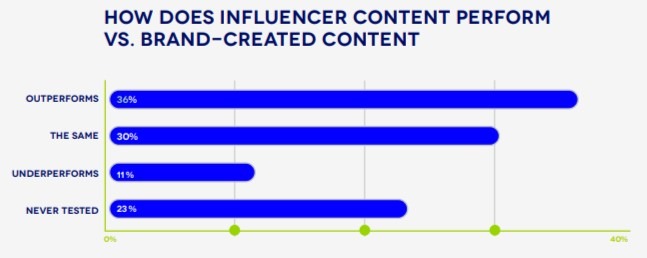
Image via Linqia
Additionally, 81% of consumers have bought or thought of buying something after an influencer posted about it.
Social media influencers can make blog posts, videos, or social media content go viral. Partnering with them comes at a cost, but the return on investment can be significant, often making the expense worthwhile compared to the substantial benefits.
The various types of social media influencers include:
Consider focusing on micro-influencers. These professionals have smaller but more engaged followings. They regularly interact with their social media audience, and their recommendations often carry more weight.
For instance, Dutch influencer Nikkie de Jager (@nikkietutorials), with 19.5+ million followers, promotes Fenty Beauty’s product here, garnering 300,000+ likes!
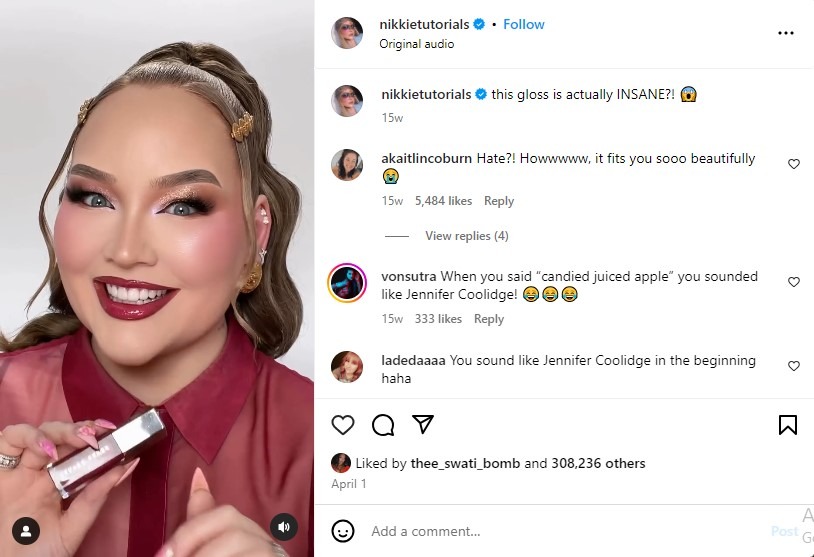
Image via Instagram
On average, people spend 17 hours weekly watching videos online.
That’s a lot of time!
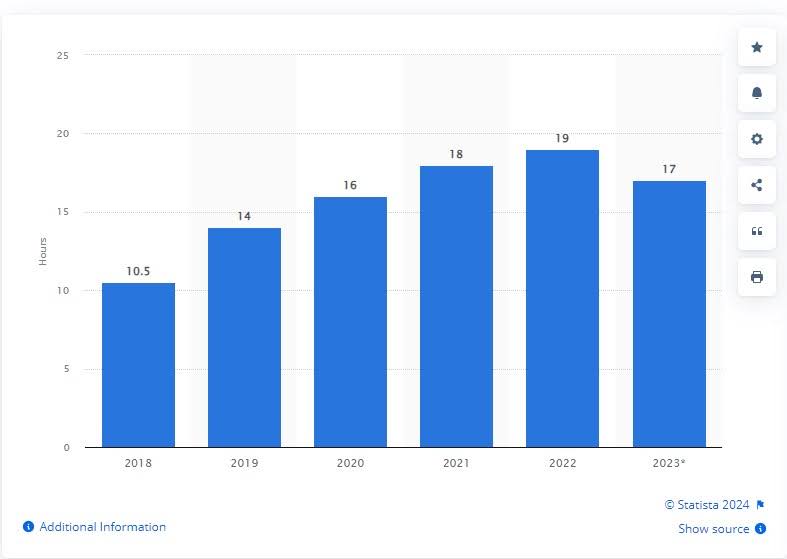
Image via Statista
Over 80% of people have bought something after watching a video about it. You can easily explain complex ideas, showcase products, or share customer testimonials. Video content can help you stand out on social media platforms.
You can create:
You can share them as social media posts, use paid promotion, or repurpose your written content to reach more people. Also including relevant keywords to your video titles and descriptions helps people discover your content easily on search engines.
Major brands, like Google, leverage YouTube videos for content promotion.
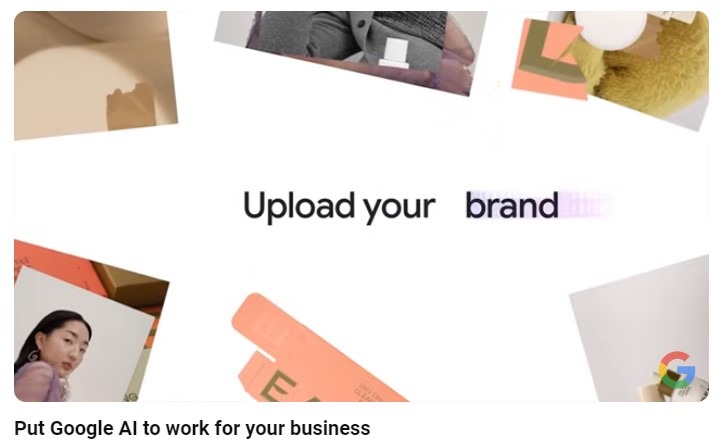
Image via YouTube
Native advertising is a smart content promotion strategy where ads blend seamlessly with the platform they appear on. They are less intrusive and more engaging, a feature CoStar Lease Accounting has leveraged here.
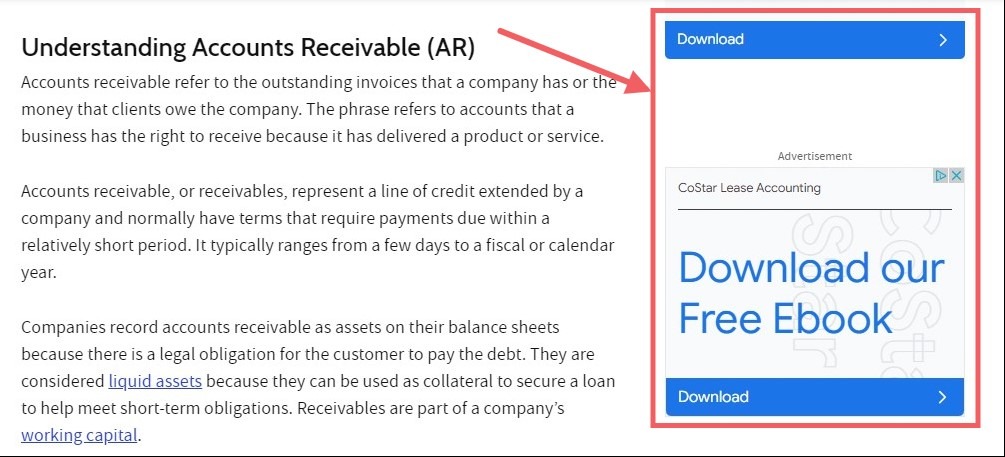
Image via Investopedia
Unlike traditional banner ads, native ads look like regular content, and they generate 53% more views than traditional banner ads.
The various types of native ads include:
This content promotion tactic is especially effective when combined with other promotion strategies like social media advertising and paid promotion.
Using internal links and creating content hubs are great content promotion strategies.
Internal links help search engines understand your site better and keep your target audience on your site longer. It’s a smart way to promote content you’ve already created.
Content hubs connect to smaller pieces of content, making it easy for your audience to find all the information they need. Plus, search engines love content hubs because they show your site has lots of relevant content.
For instance, the “Fitness & Lifestyle” section groups make it easy for visitors to find and explore valuable content on various topics.
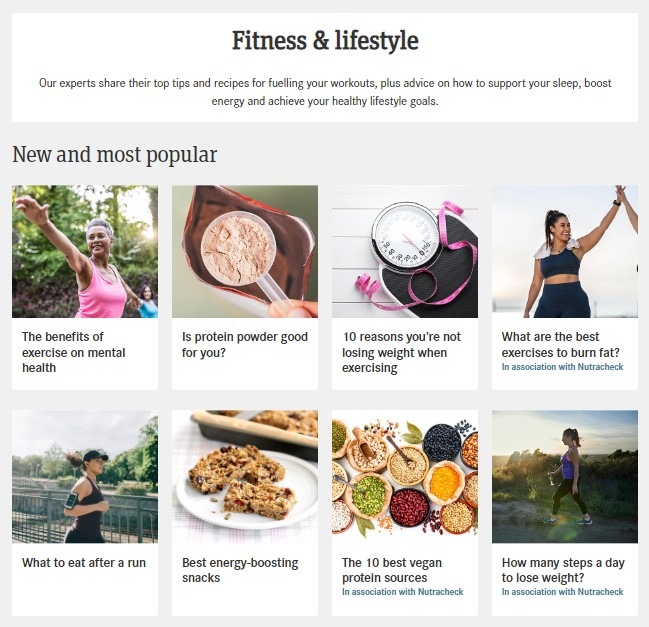
Image via goodFood
Online communities and forums are virtual spaces where people with similar interests gather to chat, share, and learn from each other. They are great for content promotion because they can boost your search traffic and help your content get noticed by search engines.
They can include:
When you share your content in these places, you reach your target audience directly, helping them discover the valuable content you’ve created. This content often includes relevant keywords that improve your search results.
These communities allow you to engage with different audience segments and understand their needs, making your content promotion efforts more effective. Also, you won’t spend as much as you would on paid promotion or other costly digital marketing channels.
Q1. What is content promotion?
Content promotion involves maximizing the reach of your content—blog posts and videos— ensuring it reaches as many people as possible. You can promote your content on your social media accounts, using search engines, and via paid promotion like social media advertising.
The goal is to get your valuable content in front of your target audience to boost your site visitors and search traffic.
Q2. What are the 7 types of promotion?
They include:
Q3. How do I create a content promotion strategy?
To create a content promotion strategy:
Q4. How often should I promote my content?
You should promote your content regularly to keep your audience engaged and attract new visitors. A good rule of thumb is to share your content 1-2 times a week and use paid ads or paid promotion strategies whenever you have something important or new to share.
Q5. How do I measure the success of my content promotion efforts?
Leverage various tools including Google Analytics, social media analytics, SEO tools, email marketing platforms, and CRMs. These platforms measure website traffic, engagement, and lead generation, and analyze data to help you improve your content strategy.
Content promotion is an invaluable part of marketing your products or services. People love good content because it helps them solve a problem, reach a goal, or fill a few minutes with entertainment.
This guide has given you numerous ways to promote your content effectively. Test them all to figure out which works best for your specific audience.
What’s your favorite content promotion strategy?